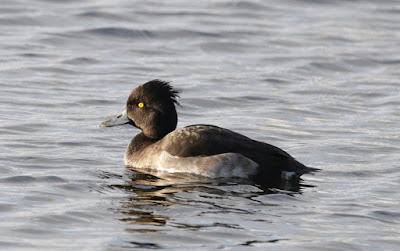The breeze was just too strong for a ringing session. Even at 10 mph we are blown off course at Oakenclough. I set off instead for a spot of birding in what would prove to be a quite productive and eventful morning.
At Lane Ends Pilling I was early enough to see the Little Egrets depart their island roost. The site is now so overgrown that it’s impossible to see the egrets from any direction, the only option being to count them in at dusk or count them out at dawn. In the morning they signal their imminent departure by their barking calls after which they fly in ones, twos and threes from the trees to the marsh below. I counted 28 heading out and landing on the marsh before they gradually scattered in all directions to later spend their day in Morecambe Bay.
Little Egret
There was a flight of Greylag Geese off the marsh and heading south over my head. I counted 70+ in just ten or fifteen minutes. By the time I reached Braides Farm Greylags were still on the move with another two parties of 40+ birds, they too heading south. There was a Kestrel here, a young bird and one of very few juvenile Kestrels I've seen this year.
There was a very good selection of waders at Conder Green by way of 270 Lapwing, 44 Redshank, 7 Greenshank, 4 Dunlin, 3 Black-tailed Godwit, 3 Curlew, 1 Common Sandpiper, 1 Snipe and 1 Oystercatcher.
Dunlin
Other “water” birds appeared as 12 Little Grebe, 3 Little Egret, 2 Grey Heron, 2 Shelduck, 1 Common Tern and 1 Kingfisher. The Kingfisher didn't come close and I was forced to watch it hovering and then plunge-diving across the pool and in front of the far island. This where the grebes hang out and where there are lots of small fish to be had.
Little Grebe
A single Whitethroat and 6 Goldfinch was the sum of the passerine count although 120+ Swallows was a welcome sight.
At Glasson the Tufted Duck numbers are building with 22 there today plus a single Great Crested Grebe, but otherwise a decent number of uncounted Common Coot and a single Grey Heron.
Tufted Duck
There were more Swallows along Jeremy Lane where the good folk of Gardner’s Farm seem not to mind their roof and TV aerial being decorated by Swallows and House Martins.
Swallow
Swallow
House Martin & Swallow
Further up the lane I had to turn around and head back. A recovery truck was on its way to rescue an Asda delivery van from the roadside ditch. Someone near Cockersands would wait in vain for their Internet shopping bags.
Going Nowhere
Asda Delivery
The lanes up here are often single track where a driver unfamiliar with local niceties like giving way to large tractors may find they are off-road with nowhere to go.
Back near Pilling again I found 4 Buzzards in the air and a Little Owl sat in the sun but sheltered from the now stiff northerly wind.
Little Owl
















































































